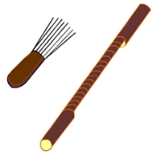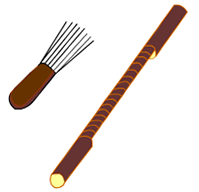
Guacharaca
Encyclopedia

Guacharaca ɣwatʃaˈɾaka is a musical percussion instrument usually made out of the cane-like trunk of a small palm tree. The guacharaca itself consists of a tube with ridges carved into its outer surface with part of its interior hollowed out, giving it the appearance of a tiny, notched canoe. It is played with a fork composed of hard wire fixed into a wooden handle. The 'guacharaquero' (guacharaca player) scrapes the fork along the instrument's surface to create its characteristic scratching sound. A typical guacharaca is about as thick as a broomstick and as long as a violin
Violin
The violin is a string instrument, usually with four strings tuned in perfect fifths. It is the smallest, highest-pitched member of the violin family of string instruments, which includes the viola and cello....
. The guacharaca was invented by native American Indians from the Tairona
Tairona
Tairona was a group of chiefdoms in the region of Sierra Nevada de Santa Marta in present-day Cesar, Magdalena and La Guajira Departments of Colombia, South America, which goes back at least to the 1st century AD and had significant demographic growth around the 11th century.The Tairona people...
culture in the region of la Sierra Nevada de Santa Marta
Sierra Nevada de Santa Marta
The Sierra Nevada de Santa Marta is an isolated mountain range apart from the Andes chain that runs through Colombia. Reaching an altitude of 5,700 metres above sea level just 42 km from the Caribbean coast, the Sierra Nevada is the world's highest coastal range...
, Colombia as an instrument to simulate the guacharaca (or Ortalis ruficauda) bird's singing. During the mid 20th century it was adopted by Vallenato
Vallenato
Vallenato, along with cumbia, is currently a popular folk music of Colombia. It primarily comes from the Colombia's Caribbean region. Vallenato literally means "born in the valley". The valley influencing this name is located between the Sierra Nevada de Santa Marta and the Serranía de Perijá in...
musicians and today it is most often associated with this musical style.
Guacharacas provide a steady rhythmic backbone for all varieties of Vallenato.
External links
- Larkinthemorning.com
- Historical Museum of Southern Florida
- FestivalVallenato.com
- Parrandavallenata.com
- Worlddiscoveries.net
Further reading
- George List, Performing Styles in Folk Music and Dance: The Mbira in Cartagena, Journal of the International Folk Music Council, Vol. 20. (1968), pp. 54-59.
- George List, African Influences in the Rhythmic and Metric Organization of Colombian Costeño Folksong and Folk Music, Latin American Music Review / Revista de Música Latinoamericana, Vol. 1, No. 1. (Spring - Summer, 1980), pp. 6-17.

